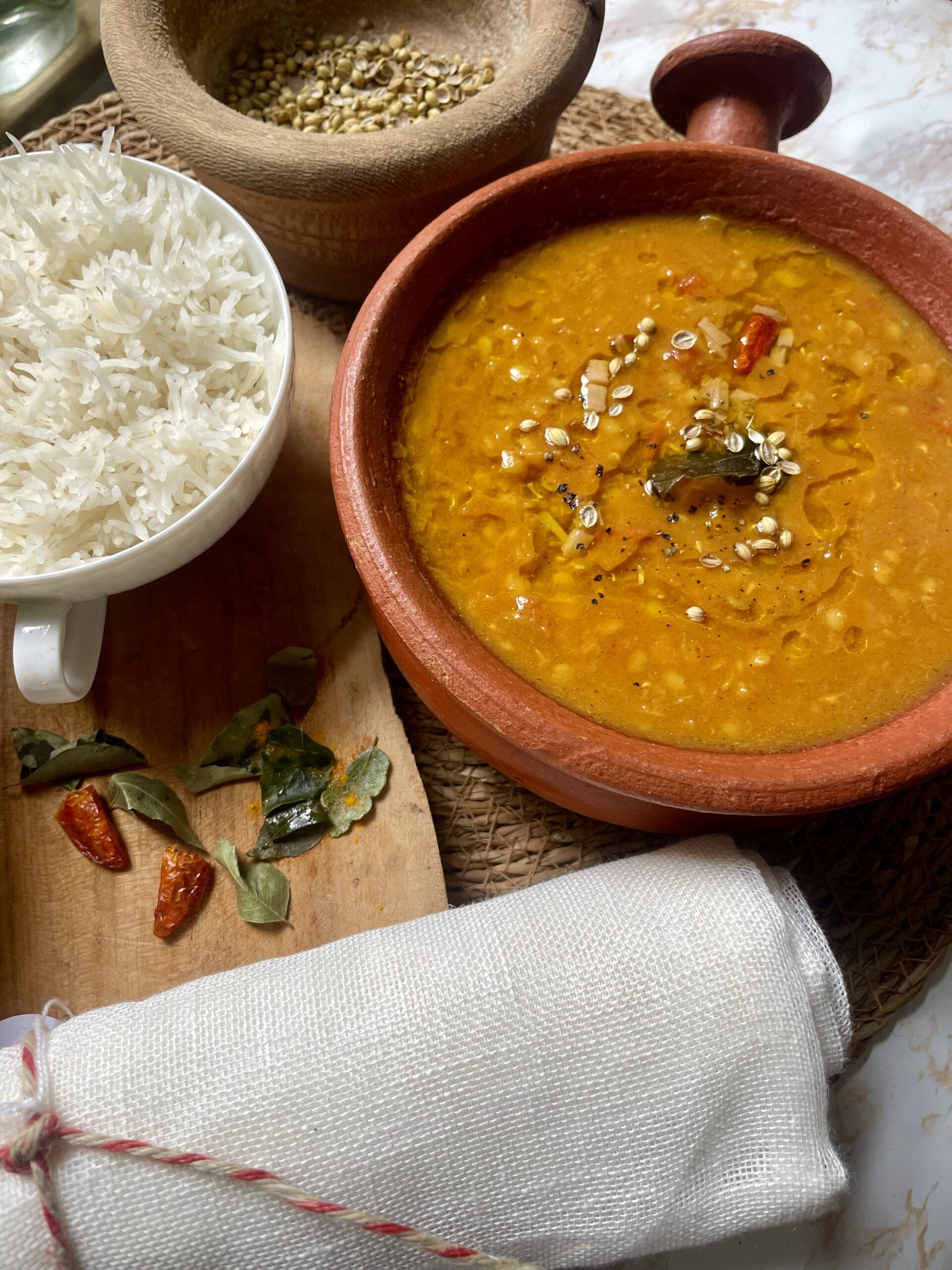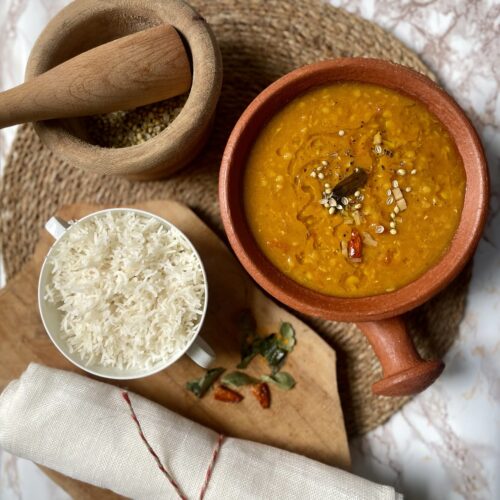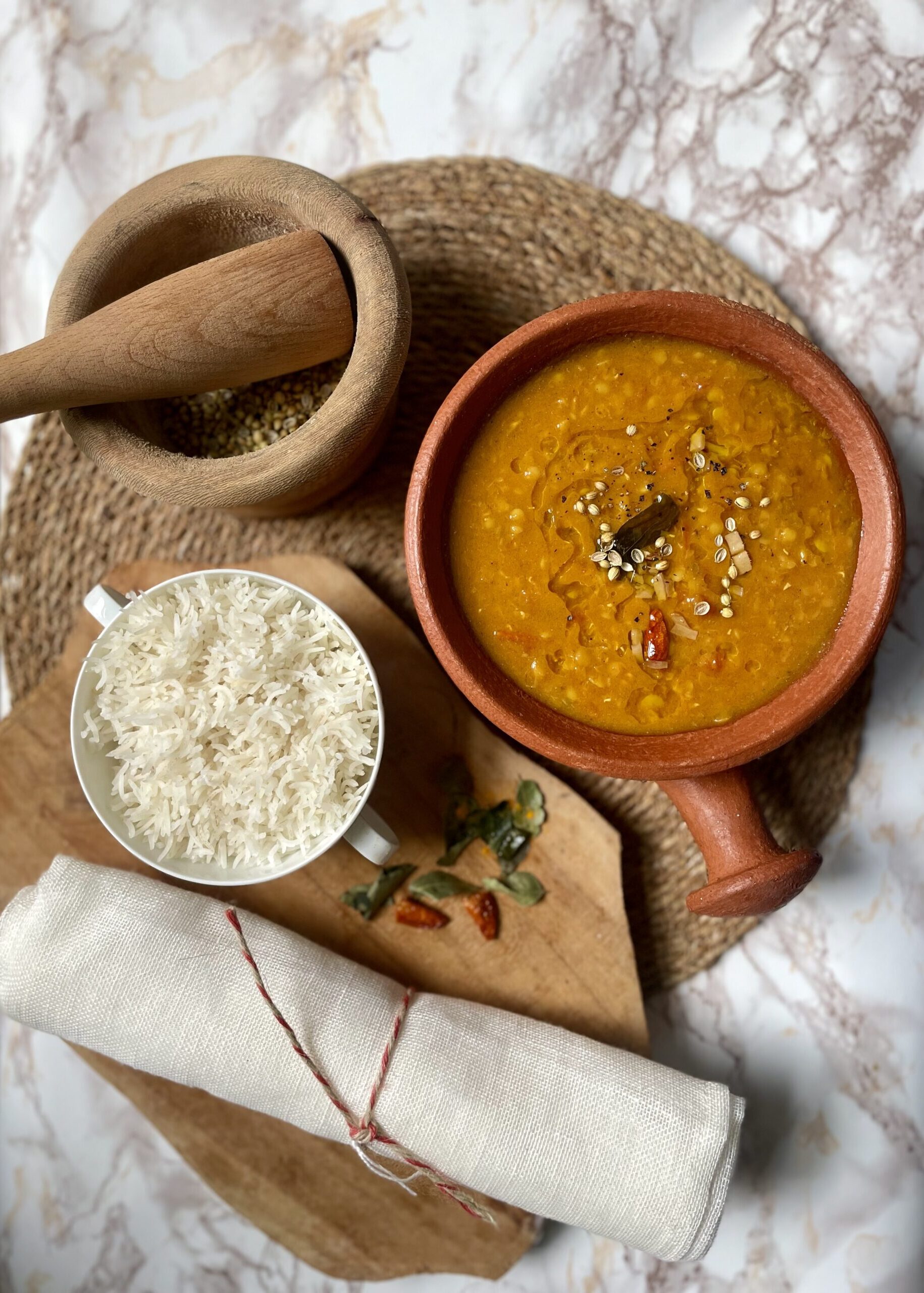This is South Asian comfort food. It’s a dish to have on weekly rotation — perfect for that mid-week meal, paired with freshly cooked rice. There are a million variations of this recipe, mine is inspired by the famous Aarti Sequira, with a few tweaks. It’s vegan and simple.
Why you’ll love this recipe
It’s pantry based, no need for fresh produce to make this everyday spiced dal – it’s vegan and a pressure cooker recipe which is what you want for busy evenings.
It’s very hands-off for the most part. This recipe is one in which you can do a lot of the prep beforehand. It works really well if you’re at home during the afternoon and want to prepare this for supper.
It’s so affordable if you have the spices on hand. Canned tomatoes and split red lentils are the main ingredients in this dish spiced with aromatics and spices – some of the most healthy and affordable ingredients out there.
How to get the most of this recipe
Watch the consistency: There’s no wrong or right with this, but I much prefer a dal that has the consistency of a thick soup. You can always add more water or cook the lentils down more to reduce some of the water, but it’s much more convenient to plan the recipe so that you end up with the consistency you like when you’re ready to serve. If you do need to add liquid, this is a great opportunity to add some self-made stock or dashi, if you have some on hand.
Soak the lentils beforehand: A great way to control the water content of this dish and enhance the taste is to soak the lentils beforehand. Soak the red lentils for a few hours before you make this recipe. Even if you only have twenty to thirty minutes before you want to start cooking, it’s worth soaking the lentils for a shorter period of time. Beware, red lentils quickly double in size.
Soaking will do two things for you: Firstly it allows the lentils to soak up all the water they need before you cook them in the pressure cooker. This allows you to better control the water content once you do add them to the pressure cooker. If you pressure cook the unsoaked lentils in the pressure cooker be sure to add a lot of water. The lentils will soak up a large amount of the water while cooking. Once under pressure, you have no control over how much water is soaked up – this may lead to a mushy texture that burns rather than cooks in your pressure cooker.
Secondly, soaking the lentils will allow the dirt and starch to release into the water. If you’ve soaked the lentils for an hour or two you will be surprised by how cloudy the water is. I am also convinced the taste is better if you drain this cloudy starchy water.
Add cream coconut or dairy if you want a richer meal. A great way to make this meal richer is to add cream; both dairy and coconut cream are great options. Add the cream before serving rather than while cooking, this looks great visually and also gives you some contrast in flavor and temperature.
Cooking essentials that make this a quick recipe
Use a pressure cooker: A pressure cooker makes this into a recipe that’s ready in thirty minutes rather than 45. I highly recommend using one, if you have one on hand. If you don’t have a pressure cooker, cook the lentils in a pot on low to medium heat for roughly 30-40 minutes. Make sure the mixture has boiled and then turn the heat down and let simmer for the remaining time. Make sure to add liquid if some of the liquid has evaporated and stir occasionally to avoid burning the bottom.
Use a stand mixer: If you have a stand mixer, this will also save you the chopping and mincing of onions, ginger and garlic. This is exactly the kind of time saving that I’m looking for when I’m cooking a weeknight dinner. If you don’t have a stand mixer, mince the aromatics by hand. This works, it’s just more labor intensive.
How to pair Everyday Spiced Dal (Vegan & Pressure Cooker)
This pairs wonderfully with fresh white rice, you can use basmati rice for a fragrant and delicate pairing. Although rice is universally South Asian, it’s more often served in South India than North India, where breads are more prevalent as the main carb.
What to serve with rice: If you’re having rice, you can add this curry leaf raita, a spiced yoghurt curry, that gives a little creaminess to the dal.
What else to serve with rice: Another perfect accompaniment ist a crispy papadum, which is essentially a lentil fritter. I buy these pre-made at the Asian grocer and deep fry them. It has a unique taste but is a little reminiscent of a crisp or a very thin cut potato chip. If you can’t find papadums, a good if not untraditional alternative is to add a few salted potato chips to serve with the dal and rice. The chips will do a good job in terms of adding some crunch to the creamy lentils and yogurt curry.
If you don’t have rice on hand you can serve dal with bread. Any bread will do, a fresh sourdough bread is untraditional but very tasty. For a more traditional pairing chose a flat bread. A pita works well, if there are available to you. If you would like a more traditional option chose a South Asian alternative such as naan, roti, chapati or paratha.
A quick intro into South Asian breads
Naan: There are so many South Asian options to chose from: The most well known in the West might be naan, a flat bread that is usually oven or tandoor baked. Naan can be bought from some European and American super markets. It’s delightful if you add some garlic oil to the fresh naan out of the oven. If you’re eager to try this – this is a good beginners recipe.
Paratha: Another alternative is the sumptuous paratha, which might be compared to a European pasty dough: It’s made by rolling dough very thinly and brushing it with oil, ghee in this case, and folding it in on itself. This is very sumptious but not the healthiest option and very labor intensive to make yourself. Frozen paratha can be bought in South Asian grocers.
Chapati: The less oily cousin of the paratha is the chapati. A chapati is a flat bread that is roasted in a skillet and made from atta, a type of course wheat flour. Some people use ghee (clarified butter) to make it but it also works fine without butter. In some places like East Africa, which has a rich history of South Asian food imported by immigrants a chapati is essentially closer to a traditional paratha.
Roti: Finally a good everyday carb option is the humble roti. This is a course and oilless pan roasted bread that is the cheapest and least labour intensive option to make.

Ingredients for Everyday Spiced Dal (Vegan & Pressure Cooker)
A note on sourcing spices: If spices aren’t accessible to you I recommend buying them online in bulk. They store well and don’t go off. Coriander, turmeric and cumin are great spices that are used in a lot of cuisines, notably Mexican and Chinese food in different combinations.
Aromatics
- 1 onion
- 4 cloves garlic
- 1 piece ginger (1cm, roughly the size of your thumb)
For the tempering oil
- 1/2 tsp cumin powder
- 1/2 tsp coriander powder
- Generous tsp turmeric powder
- Generous tsp paprika or bafaat powder
- 1/4 cup vegetable oil (sunflower or peanut) (60 ml)
Pantry Items
- 1 tin canned tomato (400g)
- two small or one large dried chili
- 1 cup dal red lentils (240 g)
Tools you may need
- Pressure Cooker
- Stand mixer / blender
- Small skillet or pan for the oil tempering
- Cutting Board
How to make Everyday Spiced Dal (Vegan & Pressure Cooker)
A note on cooking utensils: I use a blender and a pressure cooker to make this recipe. This really reduces the labor intensity and cooking time. If you don’t have either a pressure cooker or a stand mixer, you can still make this recipe with slight adjustments.
- To make the lentils, add them to a bowl, cover with water and let soak for a minimum of 30 minutes and a maximum of one day. If you have some lentils soaking and forgotten to cook them, put them in the fridge and cook them at the next possible time. Once soaked, drain the water and wash the lentils until the water runs clear. Strain the water and set the soaked lentils aside.
- Peel the onion and garlic and wash the ginger. Add these ingredients to your stand mixer with enough water to cover the onion. Blend on the highest setting so that you get a soupy consistency. Now add this mixture to the pressure cooker.
- Also add the strained lentils the pressure cooker. Do not add salt yet as this lengthens the cooking time of the lentils.
- Finally add the tin of canned tomatoes to the pressure cooker and let cook under pressure for at least 15 minutes. Once you release the pressure your lentils should be almost translucent and almost falling apart.
- Whisk the lentils, releasing the natural starch, and mash some of them so the mixture becomes thick-ish. Now add salt, to taste.
- For the tempering oil (bagaar), in a small bowl, combine the spice powders (cumin, paprika, turmeric, coriander). Mix these spices so you have a uniform spice powder. Have them ready because the next step requires you to move fast!
- In a small skillet, over a medium-high flame, warm 1 tablespoon of vegetable oil. Once the oil is shimmering, add the spices. They should sizzle and bubble a little: that’s the blooming of the spices and it’s exactly what you want. Make sure all the spices come into contact with the oil and stir with a ladle to make sure there are no pockets of dry spices. Don’t let them burn, this process is very quick! The mixture should “bloom” for about 30 seconds, no more. Immediately take the skillet from the heat. If you’re using cast iron, immediately pour the spices into the open pressure cooker with the lentils. The cast iron pan retains the heat which means even if you take the skillet off the heat the spices will continue to fry until you transfer them to another dish. If you’re using a non-stick pan you have a little more time to transfer the spices to the pressure cooked lentils.
- Pour the oil mixture into the lentils, stand back so that you don’t get hurt when the spices splutter as they come into contact with the lentils. Stir to combine. Transfer the lentils to a serving dish and serve with rice or breads.
Swaps and Alternatives
Leave out the chili if you’re sensitive to spicy food: You can always experiment with different types of chili. If you want to slowly increase the heat, buy a fresh chili cut it up and take out the seeds. This will make it far less spicy. Remember to wear gloves!
Spices and Spice mix: This recipe uses the absolute fundamental spices of South Asian food. If you can’t get your hands on cumin, coriander or turmeric powder you can still make this recipe. A good alternative for a beginner is to buy a basic curry blend, a madras curry powder works well. Use the curry blend instead of the spice mix.
A curry blend contains less of the actual spices but this is great alternative to dip your toe into the taste of these spices. It’s also usually a lot milder. Using a mild spice blend or leaving some of the spices out won’t give you the recognizable South Asian taste profile but it will still be a tasty flavorful lentil dish.
Use other lentils: Red lentils are a very affordable and quick cooking recipe, but you can make this recipe with any other lentils. The spice mix and tomatoes also pair well with yellow and brown lentils.
Tomatoes, Canned Tomatoes and Alternatives
If you have access to ripe and fresh tomatoes, use fresh tomatoes instead of canned ones. If you want to optimize for flavor, use fresh ripe tomatoes. These will give you a lovely fresh taste that canned tomatoes can’t give you.
If you are looking for a more affordable recipe use canned tomatoes instead of fresh ones. I also recommend using canned tomatoes if fresh ones aren’t in season I would highly recommend using canned tomatoes. This is cheaper and gives you a more reliable taste profile in comparison to using fresh tomatoes when they are not in season.
Stick to canned tomatoes rather than tomato concentrate. Tomato concentrate is so strong in taste that it overpowers the lentils. This really skews the taste profile of the dish – it feels like you’re eating a tomato sauce rather than a lentil dish. It’s still edible just a completely different dish.
How to store Everyday Spiced Dal (Vegan & Pressure Cooker)
If you’re living in a cold climate a cooked dal will keep well on the counter for a day. If you’re not finishing the quantity you made within a day, put it in the fridge and it will keep for a day or two more. Once the lentils start to taste sour, discard.
This recipe freezes really well. I usually make double this recipe and freeze the rest. It’s the perfect freezer dish. Once the lentils are cooked the freezing process does not change their consistency, they’re already mushy!
Did you try this recipe? I would love to hear your thoughts!

Everyday Spiced Dal (Vegan & Pressure Cooker)
Equipment
- 1 A pressure cooker
- 1 Stand mixer
Ingredients
Aromatics
- 1 onion
- 4 cloves garlic
- 1 piece ginger 1cm, roughly the size of your thumb
For the tempering oil
- 1/2 tsp cumin powder
- 1/2 tsp coriander powder
- Generous tsp turmeric powder
- Generous tsp paprika or bafaat powder
- 1/4 cup vegetable oil sunflower or peanut (60 ml)
Pantry Items
- 1 tin canned tomato 400g
- two small or one large dried chili
- 1 cup dal red lentils 240 g
Instructions
Soak the Lentils
- To make the lentils, add them to a bowl, cover with water and let soak for a minimum of 30 minutes and a maximum of one day. If you have some lentils soaking and forgotten to cook them, put them in the fridge and cook them at the next possible time. Once soaked, drain the water and wash the lentils until the water runs clear. Strain the water and set the soaked lentils aside.
Pressure Cooker
- Peel the onion and garlic and wash the ginger. Add these ingredients to your stand mixer with enough water to cover the onion. Blend on the highest setting so that you get a soupy consistency. Now add this mixture to the pressure cooker.
- Also add the strained lentils the pressure cooker. Do not add salt yet as this lengthens the cooking time of the lentils.
- Finally add the tin of canned tomatoes to the pressure cooker and let cook under pressure for at least 15 minutes. Once you release the pressure your lentils should be almost translucent and almost falling apart.
- Whisk the lentils, releasing the natural starch, and mash some of them so the mixture becomes thick-ish. Now add salt, to taste.
For the tempering oil (bagaar)
- For the tempering oil (bagaar), in a small bowl, combine the spice powders (cumin, paprika, turmeric, coriander). Mix these spices so you have a uniform spice powder. Have them ready because the next step requires you to move fast!
- In a small skillet, over a medium-high flame, warm 1 tablespoon of vegetable oil. Once the oil is shimmering, add the spices. They should sizzle and bubble a little: that’s the blooming of the spices and it’s exactly what you want. Make sure all the spices come into contact with the oil and stir with a ladle to make sure there are no pockets of dry spices. Don’t let them burn, this process is very quick! The mixture should “bloom” for about 30 seconds, no more. Immediately take the skillet from the heat. If you’re using cast iron, immediately pour the spices into the open pressure cooker with the lentils. The cast iron pan retains the heat which means even if you take the skillet off the heat the spices will continue to fry until you transfer them to another dish. If you’re using a non-stick pan you have a little more time to transfer the spices to the pressure cooked lentils.
- Pour the oil mixture into the lentils, stand back so that you don’t get hurt when the spices splutter as they come into contact with the lentils. Stir to combine. Transfer the lentils to a serving dish and serve with rice or breads.

One thought on “Everyday Spiced Dal (Vegan & Pressure Cooker)”